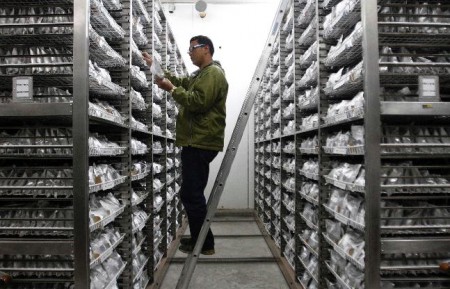- A film about community gardens in the city of Washington DC.
- “Ricos en agrobiodiversidad, pero pobres en nutrición.” Huancavelica, in Peru, has plenty of agricultural biodiversity and plenty of malnutrition. Go figure.
- Good nutrition is more important than reduced calories for longevity, in rhesus monkeys at least.
- Conservation magazine reports that return on investment is the best guide to economically-efficient conservation. We ask … well, you know what we ask, right?
Where Kasalath rice landrace really comes from
The conversation about Kasalath rice continues, with some actual information about the accession in question. The back story has kinda sorta made its way into the mainstream media too. Reuters published the picture below yesterday (30 August).
A scientist locates the rice variety kasalath inside the gene bank at the International Rice Research Institute in Los Banos, Laguna

I guess we’ll just have to take Reuters’ word that the scientist is indeed locating Kasalath and not some other sample.
Nibbles: Aguaje, Super pasta, Banana battery, Tomato love, Tomato hate, Microgreens, NUS, Fortuneii, Coffee, Uran agriculture
- Today’s new superfruit. This one doesn’t surprise me.
- Tomorrow’s super-spaghetti. This one really baffles me.
- Today’s new source of bioenergy: bananas. Shocking.
- 50 ways to love your tomatoes. Turn ‘em to jam, Pam.
- One reason to hate tomatoes, for good bad muslims.
- Trendy micro greens are more nutritious. Get ‘em young, chum.
- “If they are so good, why are they not spreading on their own?” Crops for the Future gives NUS the third degree.
- Robert Fortune, pioneer biopirate.
- Forget oil, water and phosphorus. Peak coffee is as scary as it gets.
- How to save urban agriculture: by the numbers.
Sovereign rights raises its ugly head
Where’s my guide to the netherworld of genebank databases when I need him?
I need him to make a somewhat snarky point. A recent commenter objects to the characterisation of Kasalath, the “wild” rice that’s been in the news lately, as Indian.
Kasalat is actually a Bangladeshi variety not Indian. In Bangla it means Kacha Lota or green shoot. From time immemorial it has been grown in the eastern district of Sylhet of Bangladesh from where it might have gone to India…. [I]t is just plain wrong to describe it as an Indian variety.
But as Wikipedia tells us,
The history of Bangladesh as a nation state began in 1971, when it seceded from Pakistan. Prior to the creation of Pakistan in 1947, modern-day Bangladesh was part of ancient, classical, medieval and colonial India.
So when was Kasalath collected? Or, to put it another way, what was the name of the nation state in which the place that Kasalath has grown from time immemorial found itself at the time someone collected it?
That’s what databases are for, right? IRIS, The International Rice Information System, has 12 entries for entities called Kasalath, three of them at IRRI and one in India. I couldn’t find anything as dull as an accession date for any of them. IRIS is a bit unfriendly, ((I can’t, for example, give you a link to the 12 varieties on a page; you’ll have to search for them yourself.)) although thanks to it I did also discover that Kasalath is one of about 400 varieties selected to form a Rice Diversity Panel. Until Beatrice returns from his travels, or logs on, that’s the best I can do.
And the point, of course, is to suggest that the very idea of a variety grown since time immemorial belonging to any Johnny-come-lately nation state is, alas, a cruel joke.
Featured: Genebank woes
Milko points out, in a roundabout way, that as the Bari genebank fails to sow, so it may well fail to reap:
Do they have some catalogue of their seeds published somewhere? EURISCO never managed to get any data from them.
I would hope that they know what they’ve got, but does anyone else?